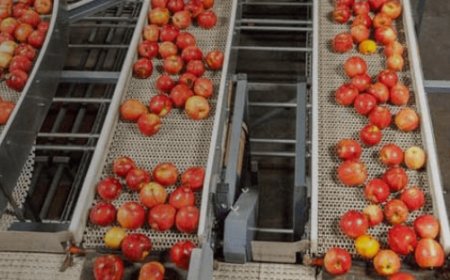How to Hike Tandy Hills Natural Area Wildflowers
How to Hike Tandy Hills Natural Area Wildflowers Tandy Hills Natural Area, located in Fort Worth, Texas, is one of the most ecologically significant and visually stunning urban wildflower preserves in the United States. Spanning over 130 acres of native prairie and limestone outcrops, this protected landscape bursts into vibrant color each spring as hundreds of species of wildflowers bloom in a sy
How to Hike Tandy Hills Natural Area Wildflowers
Tandy Hills Natural Area, located in Fort Worth, Texas, is one of the most ecologically significant and visually stunning urban wildflower preserves in the United States. Spanning over 130 acres of native prairie and limestone outcrops, this protected landscape bursts into vibrant color each spring as hundreds of species of wildflowers bloom in a synchronized display of nature’s artistry. For hikers, photographers, botanists, and nature lovers alike, visiting Tandy Hills during peak bloom season is not just a walk—it’s an immersive experience into the heart of Texas’ native flora. This guide provides a comprehensive, step-by-step approach to hiking Tandy Hills Natural Area during wildflower season, ensuring you maximize your experience while preserving the fragile ecosystem that makes it so special.
Unlike managed botanical gardens, Tandy Hills is a natural area with minimal infrastructure and no formal trails. This means visitors must navigate using topographic awareness, environmental cues, and respectful land ethics. The wildflowers here—spanning bluebonnets, Indian paintbrush, primrose, and many lesser-known natives—are not just decorative; they are vital components of a thriving prairie ecosystem that supports pollinators, soil health, and regional biodiversity. Understanding how to hike this landscape responsibly is not optional—it’s essential to its survival.
This tutorial will walk you through everything you need to know—from timing your visit to identifying key species, selecting appropriate gear, and minimizing your ecological footprint. Whether you’re a first-time visitor or a seasoned naturalist, this guide ensures you experience Tandy Hills at its most breathtaking while helping protect it for future generations.
Step-by-Step Guide
1. Determine the Optimal Time to Visit
The wildflower bloom at Tandy Hills Natural Area is a fleeting phenomenon, typically peaking between late March and mid-April, though exact timing varies yearly based on winter rainfall and spring temperatures. The best blooms occur after a wet winter followed by a warm, sunny spring. Monitor local resources such as the Tandy Hills Natural Area Facebook page, Fort Worth Botanic Garden’s wildflower reports, or the Texas Wildflower Report by the Lady Bird Johnson Wildflower Center to track bloom progress.
Visit on a weekday if possible. Weekends, especially during peak bloom, attract large crowds, which can lead to trail erosion and increased human impact. Early morning (7:00–10:00 AM) is ideal—not only for cooler temperatures and softer light for photography, but also because the flowers are often fully open and pollinators are most active.
2. Plan Your Route Before Arrival
Tandy Hills has no marked trails, which can be disorienting for first-time visitors. The area is divided into three main sections: the northern limestone ridge, the central grassland basin, and the southern slope with scattered oaks. Use a topographic map (available on the Tandy Hills Conservancy website) or a GPS app like Gaia GPS or AllTrails (with offline maps downloaded) to orient yourself before entering.
Most visitors enter from the main parking area off North Tandy Street. From there, head southeast toward the open prairie. Look for the subtle, worn paths created by previous hikers and wildlife—these are your natural guides. Avoid creating new paths. Stick to existing routes to prevent soil compaction and damage to root systems.
3. Dress and Gear Appropriately
Proper attire is critical for comfort and safety. Wear long pants and closed-toe shoes with good traction—limestone rocks can be sharp, and poison ivy, though uncommon, does grow in shaded areas. Light-colored clothing helps you spot ticks, which are active in tall grasses during spring.
Bring a wide-brimmed hat, sunscreen, and plenty of water (at least 1 liter per person). Unlike urban parks, there are no water fountains or shade structures. A lightweight, collapsible walking stick can help with balance on uneven terrain.
Carry a small backpack with essentials: a field guide to Texas wildflowers, a phone with offline maps, a camera (preferably with a macro lens), and a trash bag to carry out any waste. Never leave anything behind—not even biodegradable items like fruit peels, which can disrupt native plant competition.
4. Identify Key Wildflower Species
Tandy Hills hosts over 200 native plant species. The most iconic include:
- Bluebonnets (Lupinus texensis) – The state flower of Texas, these deep blue spikes dominate the open prairie and bloom earliest, usually in late March.
- Indian Paintbrush (Castilleja indivisa) – Brilliant red-orange bracts that appear to “paint” the grasses. Often found growing alongside bluebonnets in symbiotic relationships.
- Evening Primrose (Oenothera speciosa) – Pale pink to white flowers that open in the late afternoon, releasing a sweet fragrance.
- Blazing Star (Liatris mucronata) – Tall purple spikes that attract monarch butterflies and bees.
- Scarlet Gaura (Gaura coccinea) – Delicate, wand-like stems with pink-white flowers that sway in the breeze.
- Black-eyed Susan (Rudbeckia hirta) – Bright yellow petals with dark centers, common in mid-April.
Use a reliable field guide such as “Wildflowers of the Texas Hill Country” by Marshall Enquist or the free Texas Wildflower ID app by the Lady Bird Johnson Wildflower Center. Take photos of flowers you can’t identify and compare them later—this builds your knowledge over time.
5. Practice Ethical Observation and Photography
Never pick, trample, or uproot wildflowers. Even stepping on a patch of bluebonnets can kill hundreds of plants beneath the surface. The root systems of prairie wildflowers are deep and interconnected—disturbing them weakens the entire ecosystem.
For photography, use a macro lens to capture fine details without getting too close. Get low to the ground for dynamic angles. Avoid using flash, which can disorient pollinators. If you’re photographing insects on flowers, wait patiently—do not chase or disturb them.
Respect quiet zones. Many visitors come to meditate, sketch, or simply listen to the wind and birds. Avoid loud conversations, music, or drones, which stress wildlife and disrupt the natural ambiance.
6. Navigate with Environmental Cues
Without trail markers, rely on natural landmarks. The limestone outcrops on the northern ridge are unmistakable. The southern slope is slightly wooded with live oaks and post oaks—this is where you’ll find more shade and different species like wild ginger and spring beauty.
Follow the contour lines of the land. Wildflowers grow most densely along gentle slopes where water drains naturally. Avoid the steep, rocky crevices—they’re harder to traverse and more prone to erosion.
Pay attention to animal trails. Deer, rabbits, and even armadillos create natural paths through the grasses. These are safe to follow and rarely damage vegetation.
7. Leave No Trace
Adhere strictly to Leave No Trace principles:
- Carry out all trash, including food wrappers, water bottles, and tissues.
- Do not feed wildlife. Even well-intentioned offerings like bread or fruit can alter natural diets and attract invasive species.
- Stay on existing paths. Creating new trails fragments habitats and introduces invasive plant seeds on your shoes.
- Use restrooms before you arrive. There are no facilities on-site.
- Do not collect rocks, flowers, or seeds. All plant material is protected under the City of Fort Worth’s Natural Area Ordinance.
8. Exit Thoughtfully
As you leave, take a final moment to observe the landscape. Notice how the light changes as the sun moves. Watch for bees returning to flowers, birds flitting between branches, or the way the wind moves through the grasses. This mindfulness reinforces your connection to the land and reminds you why preservation matters.
Before driving away, check your shoes and clothing for seeds. Remove any hitchhikers—especially from invasive species like Johnson grass or Bermuda grass—and dispose of them in a sealed container. Preventing the spread of non-native plants is one of the most impactful actions you can take.
Best Practices
1. Visit During the Week and Early Hours
Weekend visits at Tandy Hills often exceed 500 people during peak bloom. This volume leads to soil compaction, broken stems, and increased litter. By visiting Tuesday through Thursday between 7:00 AM and 10:00 AM, you’ll enjoy solitude, better lighting, and cooler temperatures—all of which enhance your experience and reduce environmental stress.
2. Bring a Small Group, Not a Crowd
Groups larger than six people are discouraged. Smaller groups minimize noise, reduce trail widening, and allow for quieter observation. If you’re bringing children, prepare them in advance: explain that flowers are not toys, that stepping on them hurts the land, and that silence helps them hear the bees.
3. Learn Before You Go
Knowing even five common wildflower species enhances your visit exponentially. Use free online resources like the Native Plant Society of Texas’ website or the Texas A&M AgriLife Extension’s wildflower database. Download a printable checklist to tick off species as you find them. This turns your hike into a citizen science activity.
4. Avoid Disturbing the Soil
The limestone substrate at Tandy Hills is thin and fragile. Beneath the surface lies a complex network of mycorrhizal fungi that help plants absorb nutrients. Heavy foot traffic, kneeling, or sitting directly on the ground can crush these fungi, reducing plant resilience for years. Use a lightweight, foldable mat if you need to sit.
5. Respect Wildlife and Pollinators
Butterflies, bees, and beetles are the unsung heroes of Tandy Hills. A single patch of Indian paintbrush can host dozens of pollinators. Avoid sudden movements near them. Do not spray insect repellent near flowering areas. If you see a bee resting on a flower, give it space—it may be conserving energy for flight.
6. Report Invasive Species
Keep an eye out for non-native plants like King Ranch bluestem, Chinese privet, or garlic mustard. These aggressive species outcompete native wildflowers. If you spot them, take a photo and note the location. Report it to the Tandy Hills Conservancy via their website. Early detection is key to eradication.
7. Educate Others
If you see someone picking flowers or stepping off the path, politely explain why it matters. Many visitors simply don’t know the impact of their actions. A calm, friendly conversation can change behavior more effectively than confrontation.
8. Volunteer and Support Conservation
The Tandy Hills Natural Area is maintained entirely by volunteers and small grants. Consider joining a monthly restoration day—these events involve removing invasive plants, planting native seeds, or helping with erosion control. Your time contributes directly to the preserve’s longevity. Visit tandyhills.org to sign up.
Tools and Resources
Essential Apps
- Gaia GPS – Download offline topographic maps of Tandy Hills. Use the “Trail View” feature to simulate your route before arriving.
- Texas Wildflower ID – A free app by the Lady Bird Johnson Wildflower Center with photo recognition for over 1,200 Texas species.
- iNaturalist – Upload photos of flowers and insects to get community identifications and contribute to scientific databases.
- AllTrails (Offline Mode) – While Tandy Hills has no official trails, user-submitted routes can help orient new visitors.
Printed Guides
- “Wildflowers of the Texas Hill Country” by Marshall Enquist – The most comprehensive field guide for the region, with color photos and bloom calendars.
- “A Field Guide to Wildflowers of Northeastern and North-Central North America” by Roger Tory Peterson and Margaret McKenny – Excellent for broader identification skills.
- Tandy Hills Wildflower Checklist (PDF) – Available for free download from the Tandy Hills Conservancy website. Print and bring it with you.
Online Resources
- Tandy Hills Conservancy (tandyhills.org) – The official steward of the area. Provides bloom updates, volunteer opportunities, and educational materials.
- Lady Bird Johnson Wildflower Center (wildflower.org) – Offers regional bloom forecasts, plant databases, and native gardening tips.
- Texas Native Plant Society (tnps.org) – Hosts local plant walks and workshops in the DFW area.
- Fort Worth Botanic Garden (fwbg.org) – Often hosts guided wildflower walks to Tandy Hills during peak season.
Recommended Gear
- Macro Lens (e.g., Canon EF-S 60mm f/2.8 or Nikon AF-S DX 40mm) – For capturing intricate flower details.
- Lightweight, Foldable Seat Pad – For comfortable, soil-free sitting.
- Waterproof Notebook and Pencil – To record observations without risking ink smudging.
- UV-Protective Sunglasses and Wide-Brimmed Hat – Essential for sun protection on open prairie.
- Tick Repellent (Permethrin-treated clothing) – Apply to clothing, not skin, for long-lasting protection.
- Reusable Water Bottle and Collapsible Cup – Reduce plastic waste.
Seasonal Calendar
Use this timeline to plan your visit:
- January–February – Dormant season. Good time for planning and volunteering.
- March 1–15 – Early bloomers appear: primrose, desert parsley, and scattered bluebonnets.
- March 16–April 10 – Peak bloom. Bluebonnets, Indian paintbrush, and blazing star dominate.
- April 11–25 – Mid-season. Evening primrose, gaura, and black-eyed Susan bloom.
- April 26–May 15 – Late bloomers and seed pods. Still beautiful, but fewer flowers.
- June onward – Prairie transitions to summer grasses. Wildflower season ends.
Real Examples
Example 1: The Photographer’s Journey
Sarah, a professional nature photographer from Austin, visited Tandy Hills on April 3rd, a weekday morning. She arrived at 7:30 AM with her DSLR, macro lens, and tripod. Using the Gaia GPS app, she identified a gentle slope on the eastern edge where bluebonnets and Indian paintbrush grew in dense, contrasting patterns. She waited quietly for 45 minutes until a monarch butterfly landed on a paintbrush bloom. Her resulting photo—capturing the butterfly’s wings against the red bracts and blue flowers—was later featured in Texas Parks & Wildlife magazine. Sarah credits her success to timing, patience, and staying on the existing path, which preserved the fragile soil beneath her.
Example 2: The Family Experience
The Ramirez family from Arlington brought their two children, ages 6 and 9, to Tandy Hills on a Tuesday in early April. Before leaving, they studied the wildflower checklist together. The kids were given a small magnifying glass and tasked with finding three flowers they hadn’t seen before. They found evening primrose, blazing star, and a rare white variant of bluebonnet. At lunchtime, they sat on a mat, ate sandwiches, and listened to the wind. “I didn’t know flowers could be so quiet,” said the younger child. The family returned the next year—and brought their grandparents.
Example 3: The Volunteer’s Impact
David, a retired geologist, joined a Tandy Hills Conservancy workday in February. His team spent the day removing invasive Chinese privet from the southern slope. Using hand tools, they dug out root systems without disturbing the underlying limestone. Within weeks, native wildflower seedlings began emerging where the invasives had been. David now leads monthly tours, teaching visitors how to identify invasive plants. “I didn’t come here to hike,” he says. “I came to heal the land. And now I hike because I love what’s growing back.”
Example 4: The First-Time Visitor Mistake
A group of college students visited Tandy Hills on a Saturday in mid-April. Excited by the colors, they stepped off the path to take selfies on a patch of bluebonnets. One student picked a flower to take home. Within two weeks, the area they walked on turned brown and barren. Soil erosion followed, and by May, no flowers returned to that spot. The group later learned from a volunteer that their actions had destroyed a habitat that took five years to recover. They now volunteer monthly to help restore the area they damaged.
FAQs
Can I bring my dog to Tandy Hills Natural Area?
Dogs are not permitted in Tandy Hills Natural Area. Even leashed dogs can disturb wildlife, trample delicate root systems, and introduce non-native seeds. This policy protects both the ecosystem and the animals that live there.
Is there an entrance fee?
No, Tandy Hills Natural Area is free and open to the public during daylight hours. It is managed by the City of Fort Worth Parks and Recreation Department with support from the Tandy Hills Conservancy.
Are restrooms available?
No. There are no restrooms, water fountains, or trash cans on-site. Plan accordingly and use facilities before arriving.
Can I ride a bike or use a stroller?
No. The terrain is too uneven and rocky for bikes or standard strollers. The area is designed for foot traffic only. Use a baby carrier if bringing young children.
What if I see someone picking flowers or littering?
Politely inform them that wildflowers are protected and that litter harms wildlife. If they are unresponsive, note the time, location, and description, and report it to the Tandy Hills Conservancy via their website. Do not confront aggressively.
Are there guided tours?
Yes. The Fort Worth Botanic Garden and the Tandy Hills Conservancy offer free guided wildflower walks during peak season. Check their websites for schedules. These tours are excellent for beginners.
Can I collect seeds or plants?
No. All native plants and seeds are protected by city ordinance. Removing them, even for personal gardening, is illegal and harmful to the ecosystem. Purchase native seeds from reputable nurseries instead.
Is the area accessible for people with mobility challenges?
Due to the natural, unimproved terrain, Tandy Hills is not ADA-accessible. However, the northern ridge offers relatively flat limestone areas that some visitors with mobility aids can navigate with assistance. Contact the Conservancy for current accessibility updates.
Why are there no marked trails?
Tandy Hills is intentionally left unmarked to preserve its natural state. Marked trails would require clearing vegetation, installing signs, and increasing maintenance—all of which disrupt the ecosystem. The absence of trails encourages mindful, low-impact exploration.
What’s the best way to support Tandy Hills?
Volunteer, donate to the Tandy Hills Conservancy, share your experience responsibly on social media, and educate others. The preserve survives because of community stewardship.
Conclusion
Hiking Tandy Hills Natural Area during wildflower season is more than a recreational outing—it’s a sacred encounter with one of Texas’ last remaining urban prairies. Every step you take, every flower you observe, and every seed you leave undisturbed contributes to the survival of a fragile, ancient ecosystem. This guide has provided you with the knowledge to navigate Tandy Hills with respect, curiosity, and care.
Remember: the wildflowers don’t need you to visit. But they need you to visit wisely.
When you leave, take only photos, leave only footprints, and carry only gratitude. Let your experience inspire others—not through hashtags or selfies, but through quiet, consistent stewardship. The next generation deserves to see bluebonnets dancing under the Texas sun just as you did.
Go slowly. Look closely. Listen deeply. And never forget—you are a guest in the wild.

























